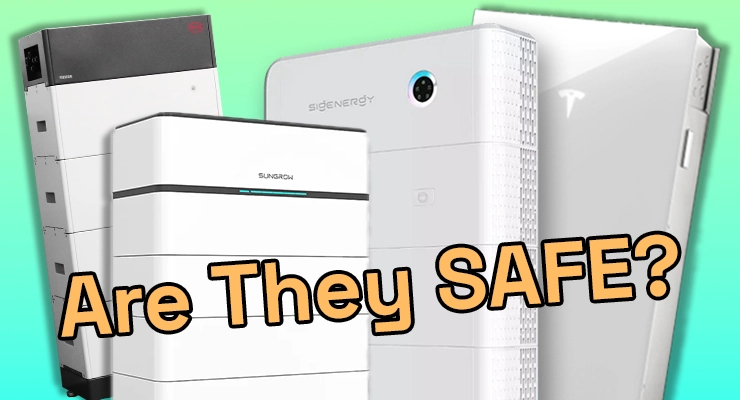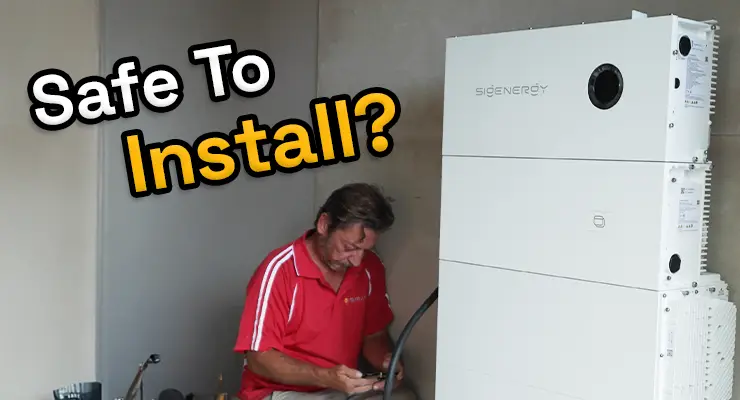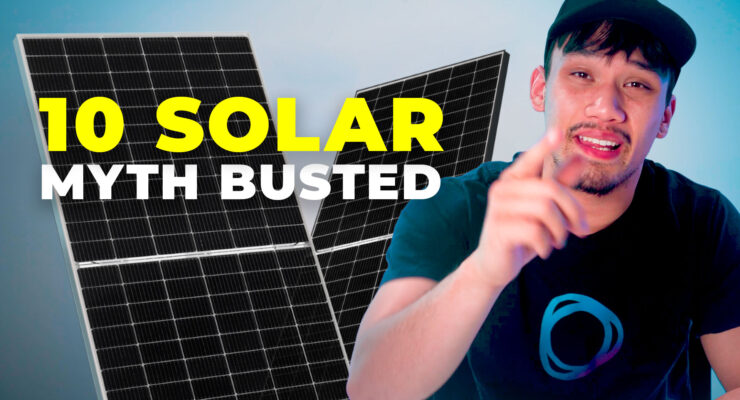
Fast read
Yes, modern home solar batteries are considered very safe when you choose a quality product that is installed correctly by an accredited professional. Australia has some of the strictest safety standards in the world, including AS/NZS 5139, which governs installation locations and procedures. The key is using a battery from the Clean Energy Council (CEC) approved product list and ensuring it is installed by a professional accredited by Solar Accreditation Australia (SAA).
How Safe Are Home Solar Batteries? A Guide for Australian Households
As Australian households increasingly turn to solar batteries to manage energy costs and ensure power reliability, safety is naturally a primary concern for many homeowners. You’ve likely heard news reports about fires related to lithium-ion batteries, so it’s completely understandable to ask whether installing a large battery system at your home is a safe decision.
The short answer is that a professionally installed, high-quality home battery system is a very low-risk addition to your home. This is thanks to a combination of advanced battery technology, robust safety features, and Australia’s stringent installation and product standards that are designed to protect you and your property.
How Australian standards ensure battery safety
Australia has a multi-layered framework to ensure the safety of home battery installations. This isn’t just a set of recommendations; it’s a system of mandatory compliance that installers and manufacturers must follow.
- AS/NZS 5139 – The Installation Safety Standard: This is the cornerstone of battery safety in Australia. It outlines strict rules about where and how batteries can be installed. For instance, the standard forbids installing batteries in habitable spaces like bedrooms, living areas, or ceiling cavities. It also mandates specific clearances from windows, doors, and flammable materials, as well as requirements for ventilation and impact protection.
- Clean Energy Council (CEC) Approved Product List: For a battery to be eligible for most government rebates and considered for installation, it must be on the CEC’s approved product list. This means the battery has been independently tested to meet high electrical safety and quality standards, including testing for risks like internal short circuits and thermal runaway.
- Solar Accreditation Australia (SAA): Following a transition period that ended on 29 May 2024, SAA is now the sole government-recognised body for accrediting solar and battery installers. Only a licensed electrician with specific SAA accreditation for batteries is qualified to perform your installation, ensuring the person designing and fitting your system has up-to-date training on all relevant standards and safety protocols.
These layers of regulation work together to ensure that, from the product’s manufacture to its final commissioning at your home, safety is verified at every step.
Understanding the risks and how modern batteries manage them
The main concern with lithium-ion batteries is a phenomenon called ‘thermal runaway’. This is a rare chain reaction where a battery cell overheats, causing a rapid and uncontrollable temperature rise that can lead to fire or the release of toxic gases. However, it’s crucial to understand that home battery systems are engineered specifically to prevent this.
The primary causes of thermal runaway include physical damage, overcharging, manufacturing defects, or exposure to extreme heat. Here’s how quality home batteries mitigate these risks:
- Safer Battery Chemistry: Most modern home batteries in Australia use a chemistry called Lithium Iron Phosphate (LFP or LiFePO₄). LFP chemistry is known for its excellent thermal stability, meaning it can withstand higher temperatures before becoming unstable compared to other types like Nickel Manganese Cobalt (NMC). This structural stability makes it significantly less prone to overheating, which is a key reason it is the preferred choice for residential applications. While all battery types have complex safety profiles, LFP’s resistance to thermal runaway is a major advantage in a home environment.
- Battery Management System (BMS): Every quality battery has a sophisticated internal computer called a BMS. This system continuously monitors the battery’s temperature, voltage, and current. If it detects any reading outside of safe operational limits, it can automatically shut the battery down to prevent damage or a thermal event.
- Robust Enclosures: Batteries are housed in durable, weather-rated enclosures (IP-rated) to protect them from physical damage, dust, and moisture. Many are also built with fire-resistant materials for an added layer of protection.
As an illustrative example of advanced safety integration, some manufacturers like Sigenergy build their systems with a multi-layered safety approach. This includes not only using stable LFP cells but also incorporating features like multiple AI-monitored temperature sensors, aerogel insulation between cells to prevent heat transfer, and an internal aerosol-based fire extinguisher in each module. Similarly, demonstrating recent leadership in safety verification, Sungrow announced in January 2025 that its SBH modular battery had achieved the rigorous UL9540A certification at both the module and system levels—a landmark accomplishment that sets a new safety benchmark for the market.
The difference between home batteries and other lithium-ion devices
It’s important to distinguish between a stationary home energy storage system and the small, portable lithium-ion batteries in e-scooters, laptops, and vapes. A significant majority of reported lithium-ion battery fires are linked to these smaller, often lower-quality, and unregulated devices.
Home battery systems are held to a much higher standard of safety engineering, testing, and installation regulation than consumer electronics. The very low number of incidents involving professionally installed home batteries across Australia—out of more than 200,000 systems installed nationally—highlights their strong safety record.
Questions to ask your installer to guarantee a safe system
Your choice of installer is just as important as your choice of battery. A qualified installer will ensure your system is safe, compliant, and performs optimally. Here are key questions to ask:
- “Are you accredited by Solar Accreditation Australia (SAA) for battery installations?”: This is non-negotiable. Ask for their accreditation details.
- “Is the battery you are recommending on the Clean Energy Council (CEC) approved product list?”: This confirms it has passed essential safety and quality tests.
- “What is the battery’s chemistry (e.g., LFP) and why is it the right choice for my home?”: Their answer should demonstrate an understanding of safety, performance, and thermal stability.
- “Where exactly will you install the battery, and how will it comply with AS/NZS 5139?”: They should be able to clearly explain the proposed location and reference the safety regulations regarding clearances and protection.
- “What safety features does this specific battery model include?”: Ask about the BMS, thermal management, and any other integrated protections.
- “What maintenance is required to keep the system safe and operating well?”: While most systems are low-maintenance, your installer should provide clear instructions on what you need to do, such as keeping the area clear of debris.
Your role in maintaining battery safety
Once your system is installed, your responsibility is simple. Ensure the area around the battery remains clear to allow for proper ventilation, and don’t store anything on top of or directly next to the unit, especially flammable materials. Periodically check that vents are free from dirt and debris. If you ever have concerns about your battery, such as visible damage or unusual noises, contact your installer immediately.
Ultimately, the safety of home solar batteries in Australia is robustly protected by strict standards, advanced technology, and the requirement for professional installation. By choosing a CEC-approved product and an SAA-accredited installer, you can be confident that you are adding a safe, reliable, and valuable asset to your home.



